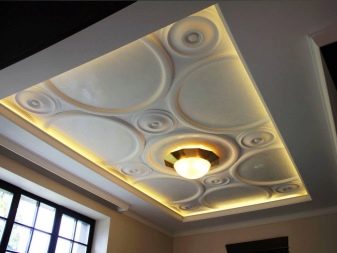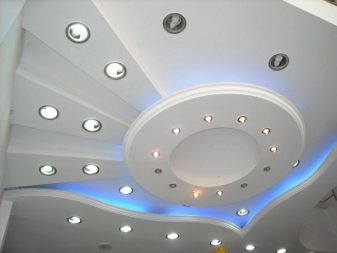Beautiful design ideas for two-level plasterboard ceilings with lighting

When choosing a ceiling design, pay attention to backlit two-level plasterboard structures. Multi-stage shapes allow you to get away from stamping and transform any room. The advantage of options with just two tiers over the others is that a ceiling with too many levels is more difficult to make technically and more costly in materials.


Advantages of plasterboard ceilings
Finishers often use drywall sheets to create new structures and structures. The reasons for this popularity of the material lie in the relatively low cost and ease of use.
There are also a number of advantages over other building materials:
- Installation of gypsum board does not take much time.
- Additional noise insulation (especially important in apartment buildings).
- Various shapes can be created from gypsum plasterboard.
- Plasterboard sheets can easily fix uneven surfaces, while avoiding the lengthy process of leveling walls and ceilings with plaster.
- GKL sheet has a small mass, which facilitates its transportation and installation.


Do it yourself
The finished look of a two-level plasterboard ceiling with backlight can scare a novice builder with its complexity. But in fact, any man can mount a simple drywall structure. Below is an example of the order of work.
- Plan. If you decide to make repairs on your own, then at the first stage, draw a sketch of the desired ceiling, while taking into account the general interior design. After the sketch, you need to make an accurate engineering calculation with a detailed plan, on which the installation locations of the frame and fasteners for drywall sheets are marked, the connection points of all lamps are marked.


Be especially meticulous about the calculation of the load and the selection of electrical elements and wires, if difficulties arise, it is better to invite a professional electrician.
For installation in plasterboard structures, choose small and not heavy fixtures, preferably if they have their own mount.


- Applying markings to the ceiling surface. Prepare the ceiling surface: remove peeling layers of old coatings (plaster, paint, ceiling tiles), cover cracks with plaster. It is better to free the room from furniture and other things, but if this is not possible, cover all surfaces with a film to protect it from construction dust. For marking, a building level is required, and even better if it is a laser tool. The lower level of the ceiling is marked on the walls, along which all elements from the gypsum board will be aligned.


- Mounting the frame for the gypsum board. A guide profile is attached along the perimeter of the ceiling (it is designated UD). Carrier profiles (CD) are mounted to the guides. Additional stability of the entire frame will be provided by direct hangers, which serve as a fastening of the profiles to the ceiling plate.
- Laying of electrical wiring. Working with electricity is very dangerous, so follow these safety rules:
- Calculate the load on the wires with a margin;
- Lay the wires in flexible non-flammable PVC pipes;
- Do not touch frame parts with bare wire ends.


- Mounting of plasterboard sheets. According to the general design, prepared elements from plasterboard are attached to the CD profiles with self-tapping screws (note that they must be designed to work with plasterboard).
- Final works:
- The joint of plasterboard elements is closed with reinforced tape, which will hide the seams and give strength. Or you can putty all the joints.
- Priming and painting of the entire surface of the gypsum board.
- Installation of a stretch ceiling (if provided by a sketch).
- Installation of external luminaires.



If you plan to contact a professional repair team, then pay attention not only to the cost of work, but also to reputation, reviews, recommendations. The cost of such work can vary greatly, depending on the region, but the average price can be considered 600-800 rubles. / sq. m, taking into account the cost of materials.
If you do not take into account the materials, then on average you will have to pay about 300 rubles for work with a plasterboard ceiling. / sq. m.


Lighting selection
For double-level ceilings, combined lighting is an excellent option. Sources of external light can be both a chandelier and spotlights (or all together), and the hidden lighting will be a diode tape, which illuminates the lower tier of the ceiling structure. LEDs cannot act as the main lighting, as they give little light, but they are an excellent decorative element.


Types of bunk structures
To make it easier for you to make your choice, let's try to conditionally classify two-level plasterboard ceilings according to different criteria.
To begin with, let's designate the options, depending on the complexity of the engineering and construction work:
- The ceiling of the room is used as one of the tiers (this is advisable only with a perfectly leveled surface).
- Combination of plasterboard construction and tensioning elements.
- All levels of the future structure are made of plasterboard.
The second and third options are more often used because they allow you to solve a number of problems:
- There is no need to level the ceiling surface.
- Suspended structures allow you to hide electrical wiring and other utilities.


Plasterboard structures can be used in a wide variety of rooms, with the exception of those where there is high humidity (bathroom).
The next sign for the classification of ceilings will be the purpose of the room:
- In the living rooms, as a rule, they have dinner, receive guests, relax, and arrange movie screenings. It is advisable to zone the room using different forms of light and ceiling designs.




Sometimes, if the overall design allows, the ceiling of the living room is decorated with a beautiful chandelier or stucco. If the living room area allows, and the ceiling height reaches 3 meters and more, it is permissible to add more complex structures in the center.





- The cabinet (office) is usually made in strict forms and not flashy colors, therefore, the ceiling must correspond to the general style of the room.
- The kitchen in apartments often functions as a living room as a reception for guests, so a ceiling with multi-level lighting will be very useful. In addition, LED backlighting, which consumes a minimum of electricity, can be very convenient as a light night light.






- Decorating a children's room is always a very interesting task, where you can give free rein to your imagination. Two-tier designs allow for more complex ideas than single-tier designs. And here, as in the kitchen, the LED strips in the ceiling, brought out into a separate switch, will act as a night light for little crumbs who are often afraid to sleep in the dark.



With the help of diodes, you can recreate the starry sky: it will be not only beautiful, but also informative. Little fans of the Star Wars saga will love it.



- The key subject of the bedroom is the bed, its location can be accentuated by one of the tiers of the ceiling.




- The hall and corridor do not need strong lighting, it is enough to insert several spotlights here, and the diode tape placed along the route will ideally emphasize the overall picture.
- For the hallway area, there should be more lighting in the place where the wardrobe and mirror will be placed.




In terms of geometric parameters, two-level ceilings are rectangular and curved, with symmetrical and chaotic patterns. The simplest and most common option, when the ceiling surface itself serves as the upper tier, and a second tier is made around the perimeter, which is subsequently illuminated by an LED strip.
This option is suitable for novice builders in order to understand the installation principle and not spoil the structure.




If the general design of the room allows, then you can add curvilinear elements (in production it is a little more difficult).



If you want something unusual, then drywall will allow you to realize the most daring design fantasies.




Helpful hints:
- Bunk structures are very rarely installed in small apartments due to the low ceiling height. But if there is a great desire, then you can make the upper tier of the ceiling slab, and the second tier - from drywall. And do not plan to build spotlights into the gypsum board, limit yourself to a diode tape, in this case you will save a few centimeters in height.
- If you are in doubt about the general design of a sketch made by yourself, then it is better to contact the designers of a construction company. For a small fee, the details will be corrected.


- When drawing up a plan and with direct installation of the ceiling, it is imperative to provide access to electrical wiring in several places.
- To make curved shapes, drywall sheets need to be moistened and only then bent.


For information on how to install a two-level plasterboard ceiling with a grid, see the next video.













The comment was sent successfully.